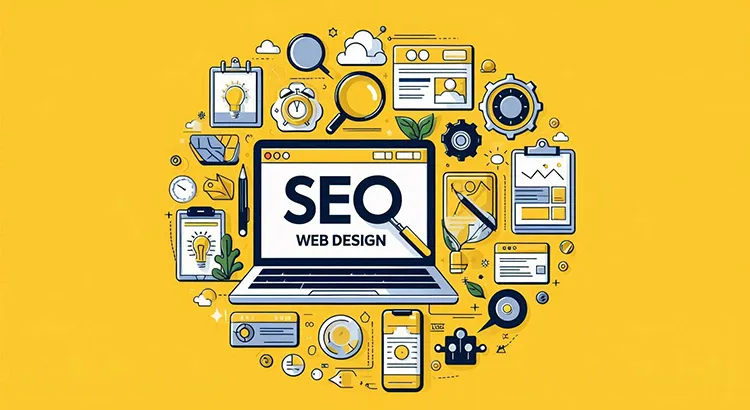If you want your business to rank on the first page of search engine results pages (SERPs), understanding SEO web design is essential. A well-designed site, optimized for search engines, increases organic traffic, enhances user experience, and drives revenue.
This article delves into the basics of creating SEO-friendly websites, its importance, and the top elements you need to optimize for better visibility.
What is SEO Web Design?
It integrates search engine optimization into the website design and development process. This means that while your site looks good, it also follows best practices to rank higher in SERPs.
Key factors like mobile responsiveness, fast load times, and clean navigation are part of creating a search-optimized website. A properly optimized website ensures Google can crawl and index its content, improving visibility and increasing traffic. Skilled SEO experts will help ensure your website design is fully optimized for Google.
Importance of SEO Web Design
Optimizing your website ensures it performs well in SERPs and delivers a seamless user experience. Here is why search-friendly site matters:
1. Increases Organic Traffic
Organic traffic consists of visitors coming to your site through unpaid search engine results. By optimizing your site, it becomes easier for users to find you on Google, leading to increased traffic and higher rankings.
2. Attracts High-Intent Traffic
SEO-optimized websites appear in SERPs for specific queries, attracting users actively seeking relevant information. This high-intent traffic is more likely to convert and builds long-term brand awareness for future conversions.
3. Improves user experience
Search-friendly design ensures easy navigation, fast loading, and mobile responsiveness. This enhances UX, which in turn boosts rankings, as Google favors websites that offer smooth, user-friendly browsing, fostering trust and satisfaction among visitors.
4. Maximizes your marketing budget
With minimal upfront costs, website optimization can be a highly cost-effective strategy. Once implemented, the improvements work over time to generate organic traffic, helping businesses achieve a strong return on investment without the need for paid ads.
Top 10 Things to Optimize for SEO Web Design
Here are the essential factors to optimize for successful website optimization.
1. Mobile-Friendliness
With mobile devices accounting for over half of global web traffic, ensuring your site is responsive on all devices is crucial. Google’s mobile-first indexing prioritizes websites optimized for mobile, so design your site to provide a seamless experience across smartphones and tablets. Effective web design services by top web designers will ensure that your website is fully mobile-friendly.
2. Website Speed
A fast-loading website is critical for both UX and website rankings. Google considers site speed a ranking factor, so optimize file sizes, minimize scripts, and choose a reliable web host to enhance loading times. Use Google’s PageSpeed Insights to identify and address specific issues affecting your site’s performance.
3. Sitemaps
A sitemap provides search engines like Google with a clear structure of your website, making it easier for them to crawl and index all your pages. This is especially useful for large websites with multiple pages, ensuring all content is visible to Google. Well-organized sitemaps help search platforms discover new content quickly, keeping your site up-to-date.
4. Readability
Content readability is essential for both users and search engines. Use clear, legible fonts and break up content with headers and subheadings to enhance user experience and make your site easier to navigate. This ensures visitors can quickly absorb the information they need, encouraging them to stay longer on your site.
5. Image File Names
Optimize image file names with relevant keywords to give Google more context about your content. Avoid generic names like “image1.jpg” and opt for descriptive, keyword-rich names like “web-design-company-bangalore.jpg.” This makes it easier for users to understand what the images are about when they are browsing or using visual aids.
6. Alt Tags
Alt tags provide descriptions for images, helping Google understand their content. Optimizing alt tags with keywords also improves accessibility for visually impaired users and increases the chances of your images appearing in image search results. Clear and accurate alt tags create a more inclusive experience for all visitors.
7. Website Navigation
Simple and intuitive navigation improves the user experience and helps Google crawl your site more effectively. Ensure that your primary product or service pages are easily accessible via internal links from the homepage and other main sections. This helps users find exactly what they need, improving overall satisfaction and reducing bounce rates.
8. URL Structure
Clean and keyword-rich URLs are an important factor for better visibility. Your URL slugs should be concise, descriptive, and include relevant keywords. This not only helps Google but also makes URLs easier for users to remember and share. Well-structured URLs improve navigation and enhance the overall user experience, especially when shared across platforms.
9. Metadata
Metadata, including title tags and meta descriptions, is what appears in SERPs. Optimize your metadata by incorporating primary keywords, and ensure title tags are concise (up to 60 characters) and meta descriptions are informative (up to 160 characters). Well-crafted metadata improves click-through rates and signals to search engines what your page is about.
10. Indexable Content
Ensure your content is in a format that Google can easily crawl and index. The most straightforward way to achieve this is by using HTML text rather than images or other media formats. Well-structured, indexable content increases the likelihood of your pages ranking on SERPs.
Final Thoughts
Optimized web design is important for driving organic traffic, improving user experience, and maximizing your marketing budget. By optimizing key elements like mobile-friendliness, speed, and content structure, you can create a search engine-friendly site that ranks higher and delivers long-term business results. Well-optimized websites foster easier access to information, increasing user satisfaction and retention.
